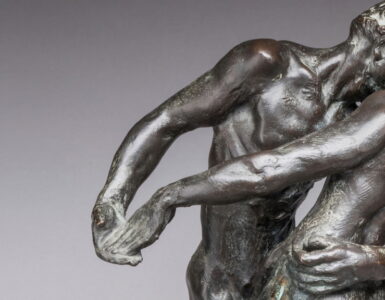
***
Evoking the elegant world of Rococo Paris, an opulent and superb exhibition of seldom seen antiquities has opened at the J. Paul Getty Center, offering a deeper insight into the life, habits and mores of Parisian high-society during the 18th Century. Paris: Life & Luxury runs until August 7, 2011.
Review by Pauline Adamek
This major Getty exhibition recreates the contents of a fashionable 18th-century Parisian townhouse, considered to be the cultural epicenter of Europe. As you proceed through the various rooms of exhibition, you will stroll through a day-in-the-life of a wealthy 18th Century Parisian and vividly imagine the complex and nuanced lifestyle of that era. In your travels, you will be surrounded by all the delicate splendors and necessities required for a typical day; gilded furniture, art works, architectural fixtures, musical instruments and so on.
By uniting prime examples of the extraordinary creative virtuosity of the period”™s great artists and craftsmen, this exhibition evokes the rich material ambiance of Paris during the mid-18th century. It brings together a wide variety of objects””from candlesticks and firedogs, to furniture and clocks, dressing gowns and jewelry, musical instruments and games””all from elite and fashion-conscious society in Paris. Seldom shown together, these objects figuratively and literally open up, allowing their functions to be understood by contemporary visitors.
Many of the items on display are valuable and fragile pieces that were acquired by the Getty Trust as far back as the 1970s. This is the first time they will be resurrected from storage and on display to the public. Other prestigious items are loans from private collections, also seldom seen.
By assembling these constellations of art and related artifacts, the exhibition follows the conventional activities in the cycle of a Parisian day, such as dressing, writing, collecting, eating, and evening entertainment””allowing visitors to envision the activities and accessories of quotidian life, and perhaps find resonances with their own daily lives.

Rising and Dressing.
In the first room we see a painting of a woman at her “˜toilette,”™ which generally involved light bathing and elaborate dressing. Getting dressed entailed being stitched into layers of one”™s garments by one”™s maids. As this was a laborious process, the lady of the house might receive visitors throughout her “˜toilette,”™ such as instructing her daughter or receiving a visit from a merchant with his wares.
The act of rising from bed and is exemplified in this installation with an exceptionally rare survivor, a bed with side curtains and a “flying” canopy suspended from the ceiling, a form known as the Lit a la Duchesse” (or “duchess style bed”). Traditionally, this elite type of ceremonial bed was reserved for the most formal, prestigious bedroom in the house and was used by important members of the family to receive visitors. There are no posts at the front, which affords full visibility for visitors.
In this exhibition, an impressive set of embroidered yellow silk-satin hangings, which measure fourteen feet tall when assembled, is being displayed for the first time since arriving at the Getty Museum in 1979.
Actual ornately embroidered gowns that were worn by wealthy women during the 18th Century are on loan from LACMA, some of which are brand new acquisitions. By displaying the gowns at almost gallery floor level, it grants us a personal perspective with which to gauge the comparatively diminutive size.
Cabinet or Bureaux Room.
The pursuit of daily correspondence and business affairs follows in the next section, with furniture and accessories related to writing, record keeping, and document filing. All but two objects are from the Getty collection. Financiers and merchants often worked in offices, called bureaux, located within the home (forerunners to the modern “home office”) but typically set apart from the domestic sphere, as portrayed in Maurice-Quentin de la Tour”™s pastel portrait of Gabriel Bernard de Rieux (1687- 1745), a prominent member of the Paris Parliament. A member of the nouveau riche, he nevertheless has himself depicted in the style of aristocratic portraiture. The almost life- size portrait is adorned with an ultra-ornate gold frame. Almost everything within the painting of Président de Rieux is evoked in a 3-D representation within the room, reproduced in all its detail by the adjacent display of many similar objects, arranged in comparable positions so that their artistic and physical characteristics, as well as their scale, can be conveyed. Hence, items such as screens, cupboards, globes and clocks give the impression of a “˜Man of the World at home.”™

Fashion Pursuits of the Day.
The activity of collecting””particularly art works””is explored in a section of the exhibition, which evokes a private Parisian galerie. Erudition and refined taste were visually expressed through the assembly and accumulation, in accordance with one”™s means, of choice works which, when arranged and displayed in a dedicated room, could provide occasion for private enjoyment by the single visitor or convivial appreciation by a group of interested guests, to show off one”™s erudition and personal taste. The assembled works often reflected the knowledge of the collector and his chosen models of virtue, drawn from the classical canon of books he read, especially the sacred scriptures, or the epic and mythological stories of ancient Greece and Rome.
The Art of the Good Table.
In mid-18th-century Paris, the main meal was customarily consumed at midday and a section of the exhibition considers the portrayal of the ingredients of the meal made under the vastly prolific and intensely versatile direction of the artist Jean-Baptiste Oudry (1686-1755). These include: still life paintings of The Four Elements painted by Oudry (which show game, fish, poultry, and vegetables); a pair of wool and silk tapestries portraying picnickers and hunters; his engraved illustration, featuring a lavishly set table, for the tale of The City Rat and the Country Rat, in the 1755 edition of Jean de La FontaineӪs famous animal fables; and the Machine dӪArgent, a still life sculpture in silver, by Fran̤ois-Thomas Germain, under OudryӪs intervention, which features a rabbit, two game birds, several types of mushrooms, and a variety of vegetables.
A section devoted to scientific pursuits examines the EnlightenmentӪs interest in the natural world, as experienced and observed empirically, and reveals how its proponents, the philosophes, were committed to the wide dissemination of knowledge. This is demonstrated by several volumes of the philosophesӪ key publications, namely the Encyclop̩die (text 1751-1762 and plates 1762-1772) by Denis Diderot (1713-1784) and Jean le Rond dӪAlembert (1717- 1783) and the Histoire Naturelle (1749-1803) by the Comte de Buffon (1707-1788), opened to illustrated pages.
Afternoon Activities.
In order to better understand “life after sunset” (before the age of electric lighting), the penultimate gallery of the exhibition focuses on two types of leisure occupations: music- making and game-playing. In order to recreate an era when nighttime gatherings were dependent upon the illumination cast by firelight and candlelight, the overall light-levels in the final gallery are lowered. A five-legged card table is installed in its open, extended position, with candles and candlesticks placed in the recesses, to suggest how the objects might have been used together.

The installation also includes an actual Parisian harpsichord of 1754 (The Metropolitan Museum of Art, New York), which survives with both its original sound box and its original lacquered surface decoration of chinoiserie motifs. The harpsichord display is complemented by ambient audio recording of Excerpts from the Suite in G major, Nouvelles Suites de Pièces de Clavecin (1726-27) by Jean-Philippe Rameau (French, 1683-1764).
The exhibition and the notional day culminate with a section devoted to private prayer in which a marquetry-veneered prie-dieu, or kneeler, a crucifix, and a hand-illuminated missal of 1720-30 are featured to demonstrate the significant role of religion in this predominantly Catholic city. Communal observance of faithful practices and private piety were an integral part of daily life, particularly quiet meditation, study of the scriptures, and self-reflection. This was facilitated in the domestic sphere by specially designed furniture such as the prie-dieu, by cabinetmaker Jean-Baptiste Tuart (master 1741), which also functioned as a writing desk and storage cabinet (Musée des Arts Décoratifs, Paris). This combined functionality illustrates how Parisian design and craft responded creatively to the multilayered needs of clients.
***
Paris was a center of great cultural achievement and artistic creativity during the reign of Louis XV, from 1723-1774, yet the virtuoso inventiveness and superlative craftsmanship of the period remain largely unfamiliar and under-appreciated today, overshadowed as they are by the tumultuous social and political events of the French Revolution of 1789.
The nation of France, and its capital city of Paris in particular, held a special status in European culture during this era. The upper echelons of societies throughout Europe were predominantly Francophiles”” intent on imitating French fashions of dress and furniture in their daily lives.
Inspired by the Getty Museum”™s extensive French decorative arts collection and the correspondingly strong holdings of French illustrated books in the Getty Research Institute, Paris: Life & Luxury will provide a rich cultural and historical experience that closely mirrors daily life in 18th-century France.
Bringing together approximately 160 objects, roughly half of which will be on loan from twenty-six museums and private collections around the world, the exhibition will include a wide range of paintings, sculpture, applied arts, drawings, metalwork, furniture, architectural fittings, lighting and hearth fixtures, scientific and musical instruments, clocks and watches, textiles and dress, books, and maps.
David Bomford, acting director of the J. Paul Getty Museum said, “Paris: Life & Luxury will transport visitors back to Paris in the mid-1700s. More than celebrating the period or perpetuating the mythology of its charm and gallantry, this exhibition re-imagines the varied and complex range of values and practices of the city”™s elite within a rich material context.”
Charissa Bremer-David, curator of sculpture and decorative arts at the J. Paul Getty Museum and the exhibition”™s co-curator added, “The exhibition will be a rich and deep sensory experience, engaging the viewer”™s initial attention with the compelling visual appeal of superlative and virtuoso works of art. From this breadth and diversity, visitors will learn generally about the contributions of the French, and in particular the Parisian, to the visual and performing arts, language, literature, history, science, and even culinary arts during this time period””in short, about their major contribution to the humanities at large.”
Paris: Life & Luxury is organized by the J. Paul Getty Museum and curated by Charissa Bremer-David, curator of sculpture and decorative arts, with Peter Bj̦rn Kerber, assistant curator of paintings. Contributors to the exhibitionӪs accompanying publication are Charissa Bremer-David, Peter Bj̦rn Kerber, Mimi Hellman, Joan DeJean, and Kimberly Chrisman- Campbell.
The exhibition is on view at the J. Paul Getty Museum at the Getty Center, Los Angeles through August 7, 2011.
Following its premier presentation at the Getty Center, Paris: Life and Luxury travels to the Museum of Fine Arts in Houston, where it will be on view September 18-December 10, 2011.
***
The Los Angeles installation of Paris: Life & Luxury is sponsored by Breguet, the premier luxury watch brand founded in 1775 by Abraham Louis Breguet.
About Breguet
Breguet is the ultimate watch brand among the 19 watch companies comprising the Swatch Group Ltd. of Biel, Switzerland, the largest watch company in the world. With boutiques in Beverly Hills, New York, Cannes, London, Paris, Geneva, Zürich, Vienna, Moscow, Ekaterinenburg, Dubai, Seoul, Tokyo, Hong Kong, Shanghai, Shenzhen, Singapore, Macao and Taiwan, the brand continues to uphold its reputation as the supplier of timepieces to people with discriminating tastes and an eye for the exceptional.
If Breguet holds a special place in European cultural heritage, it is because its founder, A.L. Breguet (1747-1823), set the standard by which all fine watchmaking has been judged. Today, his heirs at Breguet still make each watch as a model of supreme horological art. In addition to pursuing watchmaking excellence, Breguet is led toward the principle of preserving humanity”™s historical and cultural heritage well beyond the watchmaking world through various prestigious patronage activities. In recent years, Breguet has strengthened its cultural ties through partnerships with the LA Philharmonic, the Louvre, the New York Philharmonic, and the Segerstrom Center for the Arts. Its partnership with the J. Paul Getty Museum is yet another step toward promoting and preserving the world”™s great cultural institutions.
***
The J. Paul Getty Trust is an international cultural and philanthropic institution devoted to the visual arts that includes the J. Paul Getty Museum, the Getty Research Institute, the Getty Conservation Institute, and the Getty Foundation. The J. Paul Getty Trust and Getty programs serve a varied audience from two locations: the Getty Center in Los Angeles and the Getty Villa in Malibu.
Visiting the Getty Center
The Getty Center is open Tuesday through Friday and Sunday from 10 a.m. to 6 p.m., and Saturday from 10 a.m. to 9 p.m. It is closed Monday and major holidays. Admission to the Getty Center is always free. Parking is $15. No reservation is required for parking or general admission. Reservations are required for event seating and groups of 15 or more. Please call (310) 440-7300 (English or Spanish) for reservations and information. The TTY line for callers who are deaf or hearing impaired is (310) 440-7305.
Additional information is available here. Sign up for e-Getty here to receive free monthly highlights of events at the Getty Center and the Getty Villa via e-mail, or visit the official site for a complete calendar of public program.








Hallo zusammen. Echt ein lesenswerter Post. Ich wohne mittlerweile seit 4 Jahren in Wien und bin wirklich begeistert. Ich habe bereits in vielen verschiedenen Metropolen wie London oder Paris gelebt. Aber nirgends ist es so lebenswert wie bei uns.